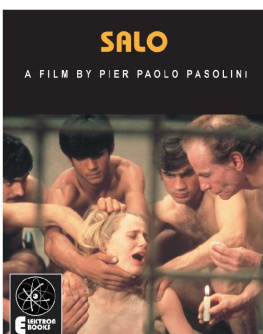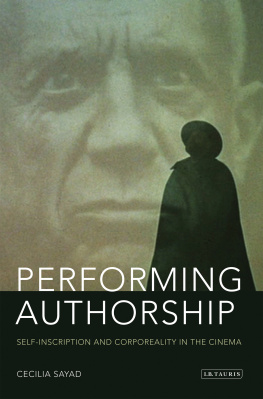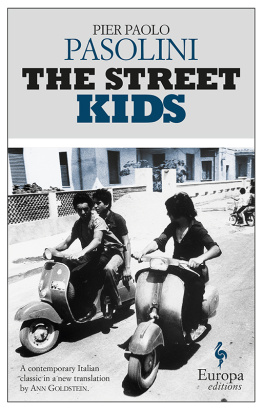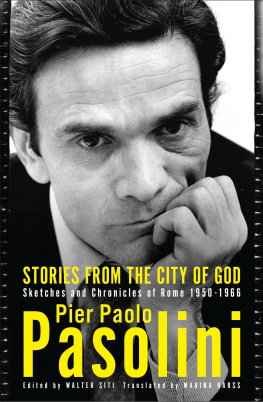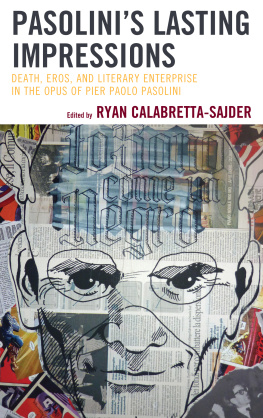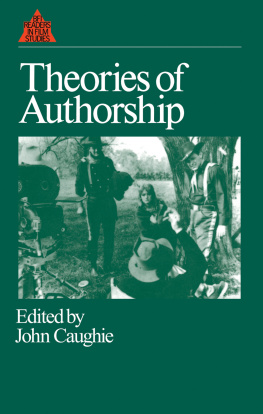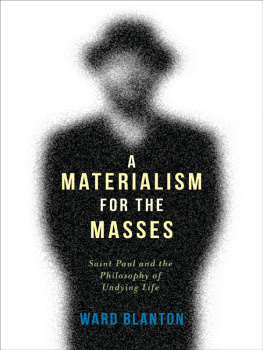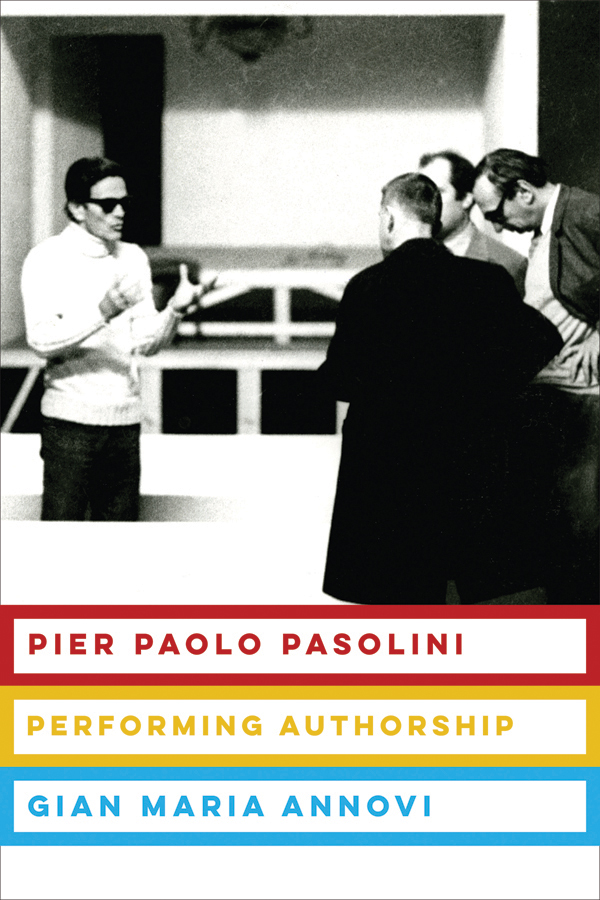PIER PAOLO PASOLINI
PERFORMING AUTHORSHIP
GIAN MARIA ANNOVI
COLUMBIA UNIVERSITY PRESS New York

Columbia University Press
Publishers Since 1893
New York Chichester, West Sussex
cup.columbia.edu
Copyright 2017 Columbia University Press
All rights reserved
E-ISBN 978-0-231-54270-8
Library of Congress Cataloging-in-Publication Data
Names: Annovi, Gian Maria, author.
Title: Pier Paolo Pasolini : performing authorship / Gian Maria Annovi.
Description: New York : Columbia University Press, [2017] | Includes bibliographical references and index.
Identifiers: LCCN 2016019912 (print) | LCCN 2016031339 (ebook) | ISBN 9780231180306 (cloth : alk. paper)
Subjects: LCSH: Pasolini, Pier Paolo, 19221975Criticism and interpretation.
Classification: LCC PQ4835.A48 Z565 2017 (print) | LCC PQ4835.A48 (ebook) | DDC 858/.91409dc23
LC record available at https://lccn.loc.gov/2016019912
A Columbia University Press E-book.
CUP would be pleased to hear about your reading experience with this e-book at .
Book & Cover Design: Chang Jae Lee
Cover Image: Courtesy of Centro Studi Teatro Stabile di TorinoTeatro Nazionale
CONTENTS
It is ironic that a project on authorship must begin by acknowledging that its author is in fact indebted to a multitude of wonderful people. They inspired, provoked, and supported me, so this book is the result of a sort of collaborative authorial performance based on a direct exchange of ideasalmost like Pasolinis. Indeed, I originally conceived the core of this project during my years at Columbia University, when a fellowship in the Graduate School of Arts and Sciences allowed me to complete my research at the Centro StudiFondo Pier Paolo Pasolini of the Cineteca di Bologna in Italy. For those crucial formative years, I am indebted to Paolo Valesio, Teodolinda Barolini, and all the faculty and students of the Department of Italian.
As this manuscript developed, I was very fortunate to be able to share my early research with my colleagues at the University of Denver: Roberta Waldbaum, Rachel Walsh, and Angela Polidori, to whom I am especially thankful. My manuscript found its final form at the University of Southern California. I am grateful to my colleagues in the Department of French and Italian and to my chair, Sherry Velasco, for their unwavering commitment to collegiality. Special gratitude goes to Margaret Rosenthal and Natania Meeker, who provided extraordinary intellectual and emotional support to help me complete my manuscript.
Some other colleagues deserve particular mention for offering their time and intelligence over the years to help me develop my ideas and for engaging me in conversations about Pasolini, literature, film, and theory. For contributing to this project, they have earned my heartfelt gratitude: Julin Gutirrez-Albilla, Stefano Albertini, Zygmunt Baranski, Marco Antonio Bazzocchi, Simona Bondavalli, Joseph Boone, Shane Butler, Luca Caminati, Laura Chiesa, Stefano Colangelo, Andrea Cortellessa, Derek Duncan, Mark Franco, Massimo Fusillo, Peter Gadol, Manuele Gragnolati, Giulio Iacoli, Niva Lorenzini, Armando Maggi, Ara H. Merjian, Davide Messina, Lucia Re, John David Rhodes, Sergio Rigoletto, and Pasquale Verdicchio.
I am immensely grateful to Roberto Chiesi, director of Centro StudiFondo Pier Paolo Pasolini, for his generosity and help during and after my period of research in Bologna. Without him, it would have been very difficult to locate many of the copyright owners of some of the images featured in this book. For their prompt assistance in making these images available to me, I thank Graziella Chiarcossi, Gloria Mereghetti, and Ilaria Spadolini of the Gabinetto G. P. Vieusseux of Florence; Riccardo Costantini of Cinemazero; Pietro Crivellaro and Anna Peyron of the Fondazione del Teatro Stabile of Turin; as well as John Baldessari, Elisabetta Benassi, Massimo Listri, Stefano Masotti, and Sandra Mior.
This project has been supported by my home institution, the University of Southern California. In particular, my gratitude goes to Peter Mancall, vice dean in the Dornsife College of Letters, Arts, and Sciences. The Deans Office helped immensely with the cost of the permission rights for the illustrations used here.
In the final stage of this project, I was helped enormously also by the insightful comments from the manuscripts anonymous readers. For their editorial assistance, I am also indebted and grateful to Justin Evans, Jamie Richards, and my graduate student Zoe Kemp.
Portions of this book were anticipated in earlier articulations in the following articles and essays: Marilyns Ashes: Celebrity and Authorship in Pier Paolo Pasolinis La rabbia , Modern Language Notes 131 (2016): 21434; La sequenza del fiore di carta: Tra metalinguaggio e metastoria, in Pier Paolo Pasolini: Pros pettive americane , edited by Fulvio Orsitto and Federico Pacchioni (Pesaro: Metauro Edizioni, 2015), 13955; Il ragazzo dal fiore in bocca: Pasolini tra vecchia e nuova giovent, in Fratello selvaggio: Pier Paolo Pasolini tra giovent e nuova giovent , edited by Gian Maria Annovi (Massa: Transeuropa, 2013), 6580; and Sal after Sal : Expanded Readings of Pier Paolo Pasolinis Last Film, in Corpus XXX: Pasolini, Petrolio, Sal, edited by Davide Messina (Bologna: Clueb, 2012), 16579. I am grateful to all the individuals who allowed me to test out part of my research during the composition of this book.
My gratitude goes to everyone at Columbia University Press who has been involved in the publication of this book, most notably my editor, Philip Leventhal, for his enthusiasm in embracing my project.
I also want to remember all the friends who have supported me in this project with their presence in my life, among them my loving family in the United States, Alessandra Nicifero and Peter Bearman; my brothers and partners in crime, Nicola Riva and Stefano Cocco; my Italian rocks, Alessandra Binini, Alessandra Ferrari, and Barbara Quinti; as well as Gabriella Bellorio, Mariana Fraga, Mariangela Guatteri, Luciano Kovacs, Laura Pugno, and Anna Santos. Finally, Joseph Keckler, for the love and dreams we shared.
Above all, I must thank my family, for being the inspiring presence in my work and life. I dedicate this book to them.
In a famous sequence from Pier Paolo Pasolinis film Mamma Roma (1962), in which Anna Magnani plays a fierce prostitute who tries to start a new life with her teenage son, Ettore, she buys him a new motorbike to celebrate his first day of work as a waiter. Excited about the gift, Ettore takes his mother on a fast ride through the Roman outskirts. Mamma Romathe eponymous nickname of Magnanis characterholds tightly to his waist and voices her dreams about their future, which Ettores untimely death will eventually shatter ( Timecode s soundtrack, which reproduces the crows querulous voice, enhances this idea. If in Hawks and Sparrows the birds pressing questions (Where are you going, my friends? Can you tell me where you are going?) problematize the destination of the protagonists journey and, symbolically, the humanity they represent, when synchronized to Timecode s images they question the future of art and society.

FIGURE 0.1. Ettore and his mother riding a motorbike.


